Everything you need to know about cooking with asparagus, including varieties, selection, storage, and nutrition information!
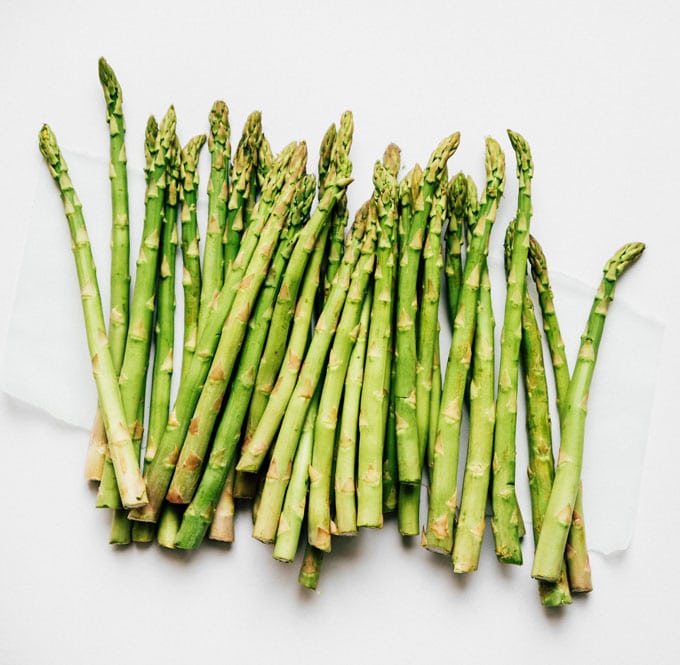
When I lived in America, asparagus season passed by with little excitement or rejoice. It was just another vegetable season, right? Not here in Europe! From April to June, everyone stops what they’re doing to go swoop up a bundle of asparagus. Why? Well not only is the growing season short here, but we have a great climate for growing white asparagus! This “white gold” defines springtime here, but this week we’ll be cooking with asparagus in all of its royal colors.
Varieties of Asparagus
All of the asparagus we eat is actually the young plant. Once the tips of the asparagus begin to open, the stalks turn very woody. Generally the thinner the stalk, the younger and more tender the asparagus.
- Green: The most popular variety, these should be available in most supermarkets during the spring.
- White: This is grown by covering the asparagus completely with soil so that they never see sunlight and begin to photosynthesize. This variety is more tender and less bitter.
- Purple: This variety, hailing from Italy, has less fiber than the green variety.
How to select and store asparagus
Look for equally sized spears with tips that haven’t yet opened. Store asparagus in the refrigerator, with the ends wrapped in a slightly moist paper towel. Alternatively, you can keep them tied in a bundle and stand them upright in a glass of water, with 1 to 2 inches of water at the base. Cover them loosely in a plastic bag. They should keep for about one week.
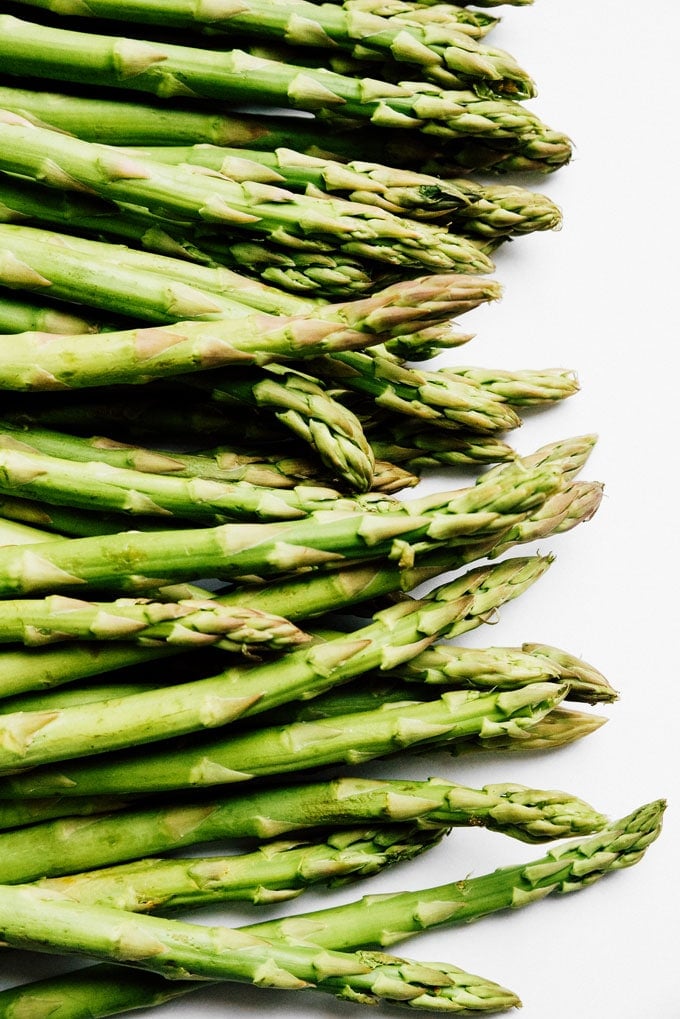
Cooking with asparagus
Asparagus contains a lot of water-soluble vitamins, which means it can lose these vitamins if exposed too much to water. When cooking with asparagus, try to aim for:
- Minimal contact between asparagus and cooking liquid (so steam them if possible, and wait to chop your asparagus into pieces until after it’s cooked)
- Minimal heat exposure
- Minimal cooking duration
A few of our favorite ways to cook asparagus are:
- Plain asparagus (how to cook it 5 ways)
- Asparagus Pizza with Burrata
- Asparagus Noodles
- Almond Crusted Asparagus Fries
- Roasted Asparagus with Romesco Sauce
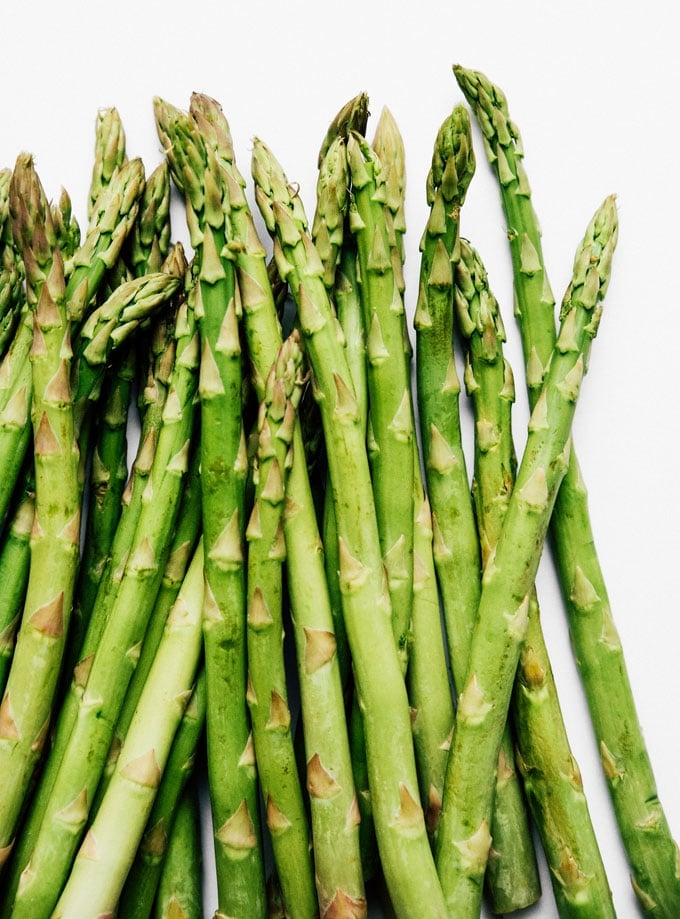
Asparagus Nutrition Information
per 1 cup raw asparagus (134 g)
- Calories: 27
- Carbohydrates: 5.3 g
- Fiber: 2.8 g, 11% Daily Value (DV)
- Protein: 3 g
- Fat: 0 g
- 70% DV of Vitamin K: A fat-soluble vitamin that allows for activation of enzymes in the clotting cascade, which is responsible for blood clotting. Also builds bone by modifying osteocalcin so that it may bind calcium, thus building the bone matrix.
- 20 DV of Vitamin A: Provides the provitamin version of this fat-soluble vitamin, meaning it comes from a plant source and your body converts the plant pigment into active Vitamin A. It is essential in many components of healthy vision, as well as immunity and cell growth/differentiation.
- 16% DV of Iron: A major component of hemoglobin, the proteins that make up red blood cells and carry oxygen around the body. This is a non-heme source, meaning it does not come from an animal. It is not absorbed as well as heme iron.
- 17% DV of Folate (Vitamin B9): A water-soluble vitamin that helps make DNA & RNA and metabolize amino acids.
- Asparagus is also packed with healthy flavonoids, like Quercetin, a flavonoid which has been linked to reduced risk of cardiovascular disease.
Is Asparagus Keto?
Absolutely! According to the USDA a 100g serving of white or green asparagus has only 1.7g of net carbs (total carbs minus fiber). That is easily worked into any keto or other low carb diet. In fact, we would assert that asparagus is the perfect food for a keto diet. At Live Eat Learn we have several times been told by keto dieters that it is hard to get much fiber on a high fat diet. Asparagus is perfect for providing a lot of fiber without adding to the carb count, and the vitamin C and potassium boost, which you don’t get much of from fatty and high protein foods, is a plus as well.
Does Asparagus Make Your Urine Smell?
This isn’t an urban legend. It does. The asparagusic acid in asparagus produces many sulfurous byproducts that give your pee a rotten-like smell. This can last up to 14 hours, but isn’t noticeable in everybody. Only 30-50% of people have this harmless asparagus side effect.
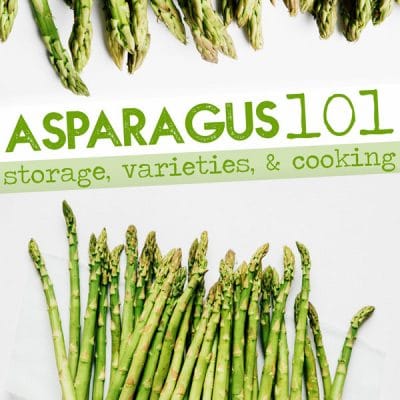

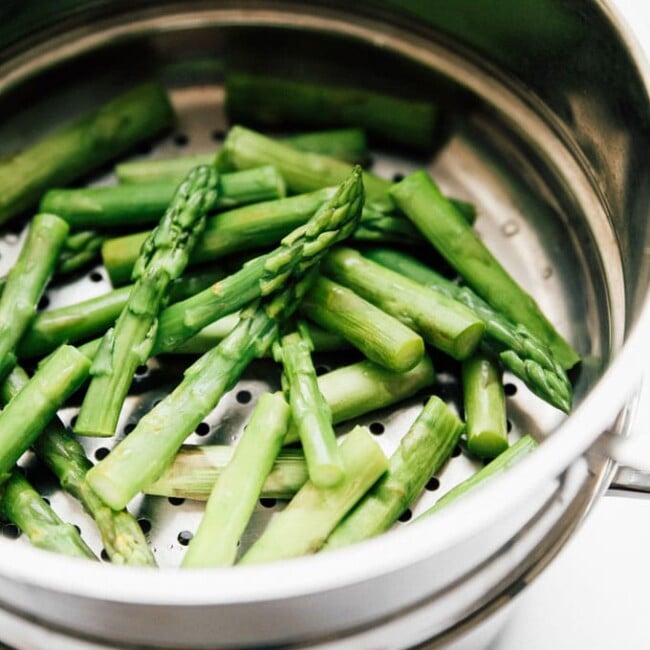


Leave a Comment